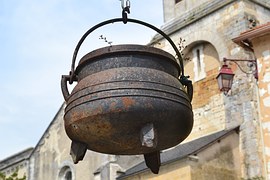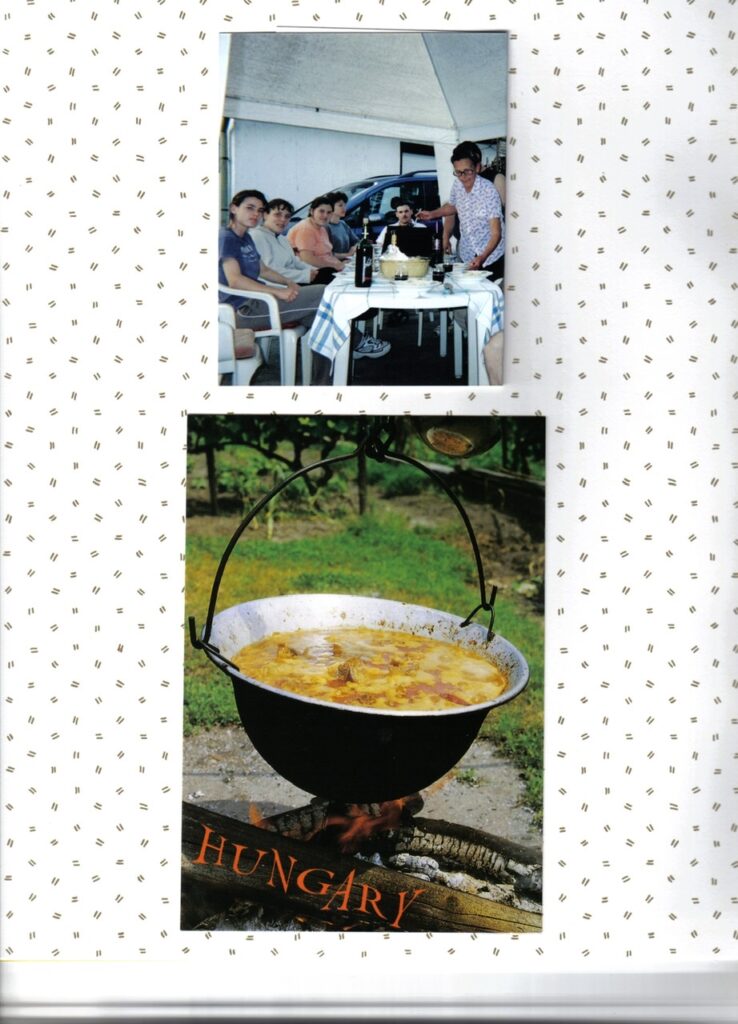
The Bajai halászlé is a well known dish in Hungary. The key ingredient is carp, which many consider to be a trash fish in the US. When I tell my American friends that my family eats carp soup (ponty halászlé) at Christmas, some have the look of pity in their eyes. They think that my family must be so poor that they have to resort to eating this dish. I then have to explain that carp soup (I’ll just call it halászlé from here on) is one of the most desired dishes in Hungarian cuisine. In fact, many of us would prefer it over foie gras or filet mignon. Many Hungarians, including my nieces, who won’t eat fish, will still eat halászlé.
There are several versions of halászlé. Some well known ones are Szegedi halászlé, Balatoni halászlé, es Bajai halászlé. Szeged and Baja are cities. Balaton is the largest lake in Central Europe (per Wikipedia). In case you’re curious, the “i” following the names of places signifies “from” or “in the style of.” Bajai halászlé is made even in Budapest, but it’s likely to be a bad imitation. For example, I had Bajai halászlé at the Szegedi Vendéglő near Hotel Gellért and it had very little in common with the real item–though, the taste was still OK.
The city of Baja takes its halászlé very seriously. Each year around mid-July, there’s a folk festival dedicated to making this dish. Approximately forty thousand visitors flood the city of about that many permanent inhabitants. The visitors come from all over the world. The city has an official web site dedicated to this event at Bajai Halfőző Fesztivál. A Google search for “Bajai halászlé” will produce a large number of hits. I got 8500 results when I created this web page.
Even within Baja, each family has a variation on the halászlé recipe. The recipe used by my family goes back at least 50 years. My nephew, Ferenc Maskál, learned it from my Dad, Ferenc Horváth, who learned it from my grandfather, Ferenc Szamolai. We’re not sure where my grandfather got the recipe from. The recipe we use changed only in a coupe of details. One of which has to do with cutting through the numerous tiny Y bones found in the carp to make consumption less tedious.
As tradition dictates, men process the carp from live fish to its final form which is added to the halászlé. They’re also responsible making the soup. The women salt the fish, grate the onions, prepare the noodles, and set the table.
The following describes the ingredients that go into halászlé, the preparation, and numbered footnotes to provide details.
Ingredients
Be warned that some of the ingredients are not easy to come by in stores in the US, including the main ingredient. Other fish may be substituted for the carp, such as bullhead, but the result won’t be the same. I tried trout, but the halászlé didn’t turn out well. I think that the fish needs to be more oily. One option is to fish for carp, which is a common fish in many lakes in the US.
- -Carp: mirror carp, 2 pounds per person (1) [any whole freshwater fish can be used, if you are short on mirror carp]
- -Salt: See the footnotes (1)
- -Water: 5.5 cups per person
- -Onion: 1 medium yellow onion per person, grated
- -Sweet paprika: 1 tablespoon per person (2)
- -Whole dried, hot chili peppers (if you like hot food) and/or frozen fresh chili peppers
- -1/2 cup of dry red table wine
- -Halászlé noodles (3), cooked al dente
I found a Hungarian grocery store on the Internet, which sells paprika in the US. However, I haven’t done any business with them yet. Unfortunately, they don’t seem to carry the Halászlé noodles. So I’ll have to post the recipe for this when my family sends me the instructions.
Preparation
– Pour the water and onions into the bogrács/cauldron (see photos under the kepek link). (You may not be able to get the bogrács in the pictures, but you’ll find something similar at the Hungarian grocery store.)
- -Once the water is boiling (4), add the prepared fish.
- -Let the water come to a boil again. Foam will form at the top, but will disappear after a
few minutes. - -Once the foam is gone, add the paprika (5) and the dried, hot chili peppers.
- -Spread the paprika in the soup with a spoon to break up the lumps of paprika.
- -Set your clock for 30 minutes. The soup will be cooked by then.
- -5 minutes after the paprika was added, pour in the wine. (6)
- -It’s very important to note that this soup should NOT be stirred. Only the bogrács is rotated back and forth in quarter turns in the horizontal plane to avoid the carp’s skin to stick to the bottom. Stirring would break up the fish.
- -15 minutes after the paprika was added, the frozen chili peppers can be added.
- -20 minutes after the paprika was added, check the saltiness of the soup and add more salt if needed.
When the soup is ready, The bogrács is removed from the fire. The fish pieces are removed onto separate plates and a little salt is added to each piece. The fish soup is ladled directly from the bogrács into the serving bowls which already contain the halászlé noodles. The fish pieces can be eaten warm after the soup, or they can be cooled in the fridge for a snack. They’re great with white bread.
Footnotes
1. It’s best to buy live carp, which is a challenge in the US. The preferred carp to use for halászlé is the Tiszai tükörponty. Tisza is a the second largest river in Hungary, about 60 miles East of the Danube river. Baja is right next to the Danube river–yet my family still prefers the carp from the Tisza. Tükörponty can be translated as mirror carp (Cyprinus carpio). The distinguishing characteristic of this carp is that it has a small number of scales, mainly along its back–an attractive feature that makes preparation very easy. The best size carp for the halászlé weighs around 4 pounds. The carp is prepared by removing the guts and the gills first. (We do use the eggs from the female and the milk from the male. These are added to the soup about 5-10 minutes before the soup is done.) The next step is really tedious, but helps with eating the fish. The fish is sliced into every 0.25 inches in order to cut through the tiny Y bones. Rather than explaining this, take a look at pictures 3 and 4 under the kepek link. The carp is NOT filleted. It is cut into 1.25 inch steaks. The fish steaks are lightly rubbed with salt on all sides and inside the cuts. The soup itself is not salted, unless the taste needs to be adjusted about 10 minutes before cooking is done. The head is cut off behind the gill cover. It is then cut in half length-wise. Again, take a look at pictures 5 and 6 under the kepek link. The carp’s brain is removed using running water and the single tooth is removed. This is known as the keserű fog, torokcsont, or torokfog in Hungarian. Unfortunately, I don’t have a picture of this tooth, but two of the Hungarian words imply that this tooth is close to the fish’s throat. If you’re lucky enough to get live carp from a pond, the live fish should be kept in a barrel or tub of oxygenated water for a few days to get rid of the muddy taste.
2. Use only sweet paprika. The best comes from private stock in Hungary, but you’d need connections to get this. The next best thing is to buy Hungarian paprika from an importer (see the Hungarian grocery store, as mentioned above). Some members of my family like their halászlé very spicy. We use dried and/or frozen whole peppers for this. An example of the type of pepper used is the Long Slim Red Cayenne or the Thai Dragon Hybrid from Burpee’s catalog. The dried pepper is placed in the soup the same time the paprika is added. The frozen pepper is added 15 minutes before the soup is done. The advantage of this approach is that the whole peppers don’t make the soup spicy–unless the soup was stirred, which would be a mistake. Those who like their halászlé spicy can squeeze and scrape the contents of the whole pepper out with their spoon in their own bowl.
3. Halászlé noodles (a.k.a. matchstick noodles) are readily available in Baja. They’re cooked separately from the soup and are a bit chewy (al dente). When the soup is served, the noodles are placed in the bowl first and then the soup is ladled on top. Check the pictures under the kepek link for a visual.
4. Use dried acacia tree branches for the fire. We believe that the smoke adds a special flavor to this soup. I expect that other dried wood besides acacia would do the trick equally well. At the beginning of cooking, the the bottom of the bogrács/cauldron is about 6 inches from the burning wood. Toward the end of cooking, the bogrács is lowered almost into the smoldering embers. The distance of the cauldron from the fire is controlled by a folded chain with a hook on the end. Again, the pictures should explain this well enough.
5. If you add the paprika while there’s still foam on top of the soup, some of the paprika will get caught in the foam and will get stuck to the side of the cauldron. This paprika will dry, “burn” and will give an undesirable bitter taste to the soup.
6. My nephew believes that adding a bit of red wine prevents the fish from falling apart. This step, along with slicing the fish to cut through bones are the only two changes made to this 50 plus year old recipe.




Leave A Comment
You must be logged in to post a comment.